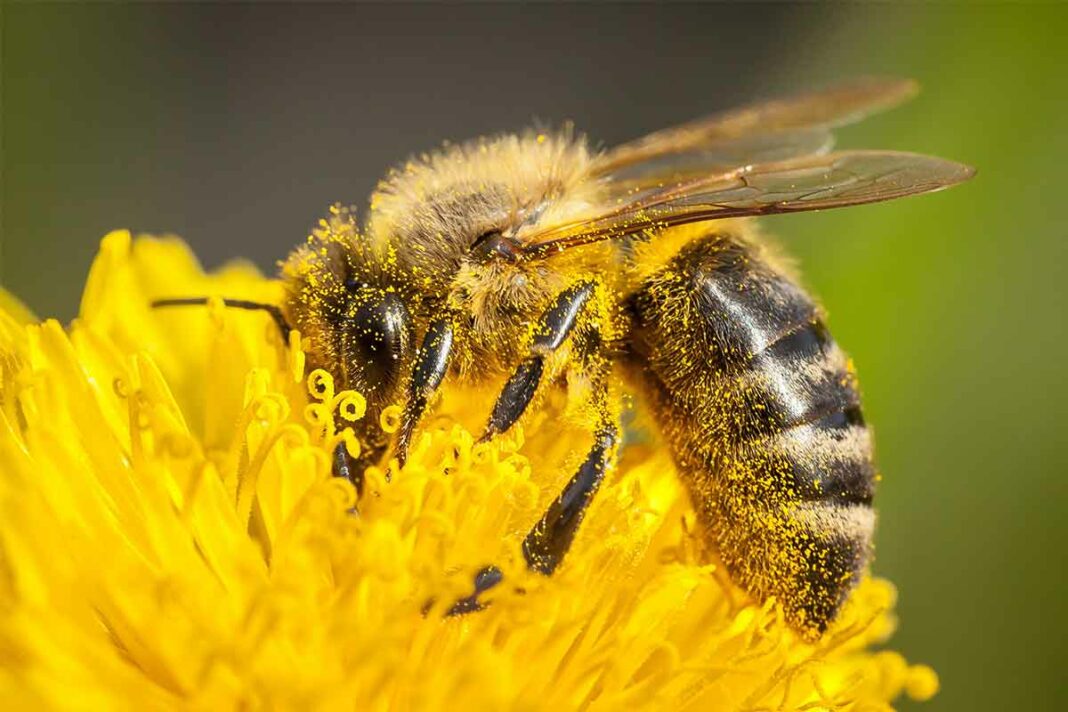MANITOULIN—Across the vast and varied landscapes of North America, a quiet crisis is unfolding. The once-familiar hum of bees, the flicker of butterfly wings, the dusk-dance of moths, all are fading. A landmark study has now confirmed what many naturalists, farmers and knowledge-keepers have long felt in their bones: our pollinators are vanishing.
Out of nearly 1,600 species of vertebrate and insect pollinators assessed—those responsible for fertilizing the plants that feed and sustain us—22.6 percent face an elevated risk of extinction. In Canada alone, over 10 percent of the 759 species studied are at risk. In the United States, the figure climbs to 22.5 percent out of 1,579 species reviewed.
Bees bear the heaviest burden. Of the 472 bee species examined across Canada and the US, a staggering 34.7 percent—over one in three—are at risk of extinction. Digger bees and leafcutter bees are especially imperiled, with nearly half of their species teetering. More than a quarter (28 percent) of all North American bumble bees are facing some level of extinction risk. The rusty patched bumble bee and Franklin’s bumble bee are already critically endangered—ghosts of abundance now confined to shrinking habitat pockets.
And yet, despite the urgency, long-term, consistent monitoring of pollinators remains scarce. Much of what we know comes not from governments, but from museum records, citizen scientists, and a few tireless researchers, like John Klymko of the Atlantic Canada Conservation Data Centre. He co-authored this landmark study and offers a sobering insight: “To see over one-fifth of species at risk—those numbers are alarming. But they’re real.”
Butterflies follow close behind, with 19.5 percent of 632 species at risk. Moths, often overlooked, are also in peril: 16.1 percent of 142 species face extinction. Even flower flies—those mimicry masters that pose as bees and wasps—are not exempt: 14.7percent of 295 species are at risk. Beetles, while the least threatened among insect pollinators (12.5 percent of 18 species), still show more species at risk than birds, though this estimate carries greater uncertainty due to gaps in data.
And the vertebrates? All three species of pollinating bats are considered at risk. Hummingbirds, among the 17 species studied, have shown population declines, but for now, their numbers remain high enough to avoid an at-risk classification.
Some pollinators—like flower flies—mimic the stingers they are not, relying on deception to evade predators. Their beauty is a sleight of hand. Others, like the three species of pollinating bats, hang by a thread. Even beetles, seemingly safe, are quietly slipping.
These aren’t just numbers. These are relationships unravelling. Each lost pollinator pulls a thread from the intricate weave of ecosystems, many of which we rely on to feed ourselves. Pollinators are responsible for over $15 billion in food production annually in North America. They fertilize the blueberries, squash, apples, and beans we eat; they sustain the meadows and forests we cherish. Without them, the land grows silent. The table empties.
The risks aren’t evenly spread. Biodiversity hotspots are also extinction hotspots. British Columbia, with its 487 species of pollinators—the highest in Canada—also has many species with small, restricted ranges. These range-restricted species are more vulnerable by nature, and in regions like southern Ontario, the prairies, and the Okanagan Valley, a heavy human footprint—urban sprawl, monoculture farming, and industry—pushes them closer to collapse.
The culprits are many: habitat loss, pesticide exposure, disease, invasive species, fire and hydrological regime changes and the growing chaos of climate change. Nearly 99 percent of tallgrass prairie, a crucial habitat for bumble bees, has been lost to industrial agriculture. Pesticides like neonicotinoids don’t just target crop pests—they drift and linger, disrupting navigation and immune systems in wild bees. Diseases like Nosema and the parasitic Varroa mite have weakened bee populations across the continent.
Climate change, meanwhile, disrupts ancient rhythms. Flowers bloom too early or too late. Pollinators wake to barren landscapes. Droughts, floods, and fires carve into fragile habitats. In Canada, pollinator species with wide ranges across boreal forests are currently more secure, but species tied to rare ecosystems or southern climates are deeply vulnerable.
Despite this, long-term, standardized data on pollinator populations is scarce. The study relied on digitized museum records and citizen science initiatives, patching together what governments have failed to monitor.
Pollinator Conservation: Turning Risk into Recovery
The widespread risk to pollinators across North America highlights the urgent need to integrate their protection into conservation policy and land management. In the United States, pollinator species listed in State Wildlife Action Plans (SWAPs) are eligible for funding and often receive more attention from land agencies. Several states have also developed dedicated pollinator plans that focus on habitat conservation, research and public outreach.
Agricultural practices in the western plains of Ontario are a major source of threat, but they also present opportunities for mitigation. Reducing pesticide use, planting wildflower strips, and enhancing off-field habitats like roadsides and solar installations can help buffer pollinators from harm. Managing vegetation on utility corridors and improving connectivity between habitats can also reduce local impacts—and in doing so, help pollinators better adapt to climate change.
Livestock grazing, particularly across the western United States, poses another challenge. Grasslands, deserts, shrublands, and other open ecosystems are essential pollinator habitats. Integrating pollinator-friendly practices—such as seasonal grazing rotations and planting native flowers—can help maintain both agricultural productivity and biodiversity.
In Canada, provinces and territories also have a critical role. Boreal and arctic pollinators, including rare butterflies like the northern ringlet, are part of uniquely northern ecosystems. The information in this study can support assessments through the Committee on the Status of Endangered Wildlife in Canada (COSEWIC) and help identify candidates for protection under the federal Species at Risk Act.
Efforts to restore pollinator habitat using broad guidelines have been shown to increase pollinator numbers and diversity, though often benefiting common species first. Protecting rare and region-specific pollinators may require more focused action, especially in areas where threats overlap. Because at-risk pollinators are found in every state, province, and territory, conservation actions can be taken almost anywhere—and will benefit broader biodiversity beyond pollinators themselves.






